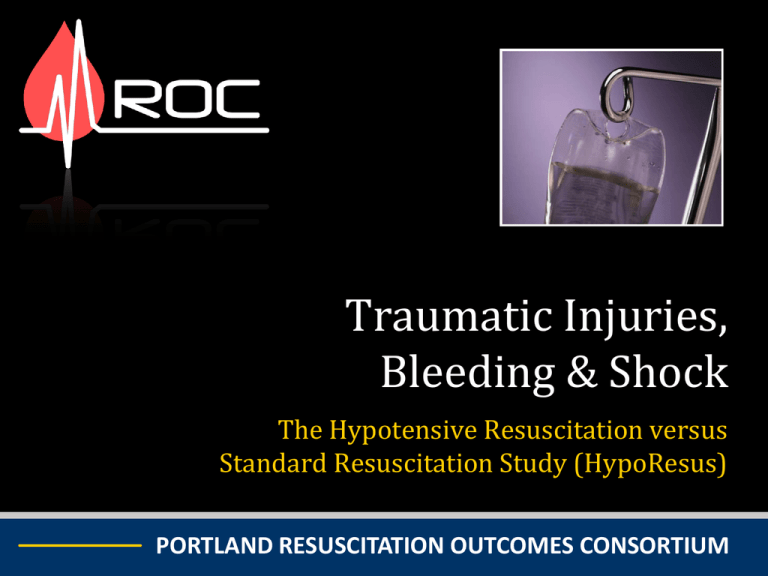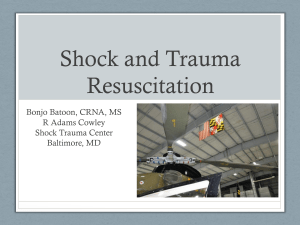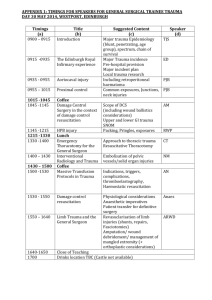the PowerPoint - Oregon Health & Science University
advertisement

Traumatic Injuries, Bleeding & Shock The Hypotensive Resuscitation versus Standard Resuscitation Study (HypoResus) PORTLAND RESUSCITATION OUTCOMES CONSORTIUM What is this forum about? To seek your opinion on the potential involvement of yourself or a family member in a research study of IV fluids in patients that suffer traumatic shock from blood loss, that will be done under Exception From Informed Consent (EFIC) guidelines. Traumatic Injuries • Trauma is the leading cause death for persons between the ages of 1 and 44 years. It is also among the top 10 causes of death across all age groups. • Severe bleeding, head and spinal cord injuries, or a combination of these result in 80% of trauma deaths. • More than half of trauma deaths occur within the first 12 hours after the injury. • The most preventable death after trauma is exsanguinating hemorrhage–severe bleeding that leads to shock. The presence of shock can be detected by a low blood pressure, fast heart beat, confusion, pale skin, feeling cold Deaths from Trauma • Immediate—50% (at scene) Massive brain or spinal injury, cardiovascular event • Early—30% (within first 24-48 hours) Severe brain injury, shock due to blood loss from torso trauma • Late—20% (days to weeks) Multiple organ failure and overwhelming infection Influenced by inadequate early resuscitation or care Field Management of Severe Blood Loss • There are two major types of bleeding: internal and external. There are currently no direct methods for controlling bleeding resulting from internal injuries in the field. External bleeding is managed with pressure dressings, tourniquets and other methods. Tourniquet Treatment of Severe Blood Loss • Traditional treatment for shock related to severe blood loss is aggressive intravenous (IV) fluid administration. The purpose is to attempt to restore circulating blood volume and an adequate blood pressure. Fluids used in the field are typically either normal saline (salt water solution) or Lactated Ringer’s solution (balanced solution); also referred to as “crystalloids.” This treatment method is currently endorsed by the American College of Surgeons Committee on Trauma. Current guideline is to give trauma patients with shock two or more liters of fluid. Current Science & Studies • Over the last 20 years, the practice of giving a high volume of fluids for shock has come under some question. Clinical and basic science literature does not support this practice. • There is growing evidence that early aggressive fluid resuscitation with crystalloid-based fluids is associated with a variety of complications. • Both human and animal studies have shown the benefit of delayed and minimal fluid resuscitation until severe bleeding has been controlled. Current Science & Studies continued… • Human trials and observational studies have compared early aggressive fluid administration to either delayed fluid administration or minimal fluid administration. Some of this research has come from the military conflicts in Iraq and Afghanistan. • One study compared standard fluid administration to no fluids until patients arrived in the operating room. Patients with delayed fluids had a higher survival rate and fewer complications than those with standard fluids. • Another similar study was conducted in the hospital setting. In this case, survival was the same in both groups. Current Science & Studies continued… • Two other studies compared fluid administration to no fluids in the field. One found that the practice of fluids given in the field was associated with a significant increase in the risk of death. Another compared trauma patients transported by EMS to those transported by private vehicles in Los Angeles. Despite similar injuries, the outcome was much better in those transported by private vehicles. The authors hypothesized that delays in transportation and IV fluids in the field contribute to increased death. Significance of the Research • When internal bleeding occurs, blood clots form. • It is the body’s attempt to stop the flow of blood. Similar to plugging a hole in a leaking hose. • The theory is, giving these patients large amounts of fluids dilutes the blood (minimizing the ability to clot) and “pops” open the plugged holes. Significance of the Research continued… • Neither early aggressive administration of fluids in the field, nor minimal or no fluid administration has proven to be superior. • Given that the current standard of care may be harmful to trauma patients, a more comprehensive study is both ethical and needed. • It will be important to ultimately determine which strategy for the treatment of severe bleeding is best for trauma patients. Goal of the HypoResus Study • The primary aim of the trial will be to: To determine the feasibility and safety of minimal fluid administration for the early treatment of patients with traumatic shock, compared to standard fluid administration. Big Bag (1000 ml) Small Bag (250 ml) versus Simply… we want to determine what is the BEST treatment strategy for trauma patients suffering severe blood loss. Study Fluids Temporary photo until new kits available Study Design • Randomized controlled trial (a common method used in clinical research). • A sealed container will have either two small bags of normal saline or one large bag of normal saline • EMS personnel will not be able to see (“blinded”) the contents of the containers until it is open. • If it contains a large bag, the patient will receive high amounts of fluid administration. • If small bags, patient will receive a minimal amount of fluid. Eligibility for Enrollment BLUNT OR PENETRATING TRAUMA PATIENT IN SHOCK (with no head injury) OPEN STUDY KIT GIVE WHICHEVER BAG OF FLUID IS CONTAINED IN KIT “Opt-Out” Option • Will be provided if desired. • A “No Study” bracelet will be provided for those who request one. *To request a bracelet, call: 503-494-8083 or email roc@ohsu.edu Notification & Consent • Will be done as soon as possible after enrollment, and will allow for an opportunity to withdraw from further participation. • Consent is obtained for the continued review of your medical record, and only related to the current admission. Safety Monitoring • The study will be monitored by: Data Safety Monitoring Board (DSMB)—an independent group Institutional Review Board (IRB) Food & Drug Administration (FDA) National Institutes of Health (NIH) What is Exception from Informed Consent (EFIC) • A federal regulation (21 CFR 50.24), allows certain studies that meet the following criteria to use this exception: Patients’ lives must be at risk. Available treatments are not satisfactory. Patients are unable to give consent. Potential risks are reasonable. Participation in the research could provide a direct benefit (increased survival) to the patient. The research could not be carried out practically without this exception. EFIC Regulations • Require community input and commentary for the proposed research. Public disclosure Community consultation • Eligible patients for this study will require immediate resuscitation, since without intervention, patients in shock face imminent death. • Traditional informed consent is impossible because: Patients with severe traumatic injury are unconscious, or in shock and not capable of providing consent. Resuscitation has to be started immediately, and next of kin may not be immediately available, or are likely to be too distraught to understand an explanation of the study. Questions? Do you have any concerns regarding this proposed research study? For more information, visit our website at: www.ohsu.edu/emergency/roc Supplemental Slides To be used if questions about heart attacks come up in the discussion. Who will be included in the study? Patients Included Patients Excluded • Those with blunt or penetrating injuries (abrasions, lacerations, hematomas, etc.) • Severe head injury • Patients in shock (systolic blood pressure less than or equal to 90) • Known prisoners • Age greater than or equal to 15 years Or, if age unknown, a weight of greater than or equal to 50 kg • Drowning or hanging • Absence of severe head injury Or adequate level of consciousness • Previous IV fluids given (>250 ml) • Ongoing prehospital CPR • Known/suspected pregnancy • Significant burns • Time from dispatch >4 hrs • Blood pressure greater than 90 • Age less than 15 years Or weight <50 kg, if age unknown Field Intervention Procedures Hang 1000 mL bag Administer 2000 ml TKVO if SBP >110 mmHg, restart if SBP <110 mmHg ELIGIBLE PATIENT Radial pulse or SBP >70 mmHg Run slowly TKVO (keep vein open) Hang 250 mL bag No radial pulse or SBP <70 mmHg *Reassess SBP or radial pulse and repeat PRN Give 250 ml* Trauma Prevention • Three basic strategies (Haddon) • Education and persuasion e.g., safety messages, drivers education • Legal regulation of behavior e.g., using drugs and/or alcohol • Automatic protection e.g., safer vehicles Portland-Vancouver Metro EMS System • Accessed by dialing 9-1-1 • Dual ALS system • First Response (4-6 minutes) Fire ALS Engine, Truck or Rescue One or more paramedics • Transporting Ambulance (within 8 minutes) One or two paramedics • Aeromedical system (400 scene calls/year) Tri-County Level 1 Trauma Centers Legacy Emanuel Hospital & Health Center Oregon Health Sciences University Clark County Level II Trauma Center Peace Health Southwest Medical Center Hospital Trauma Team Response • Trauma Team Trauma surgeon Emergency physician Anesthesiologist Trauma nurse Others





